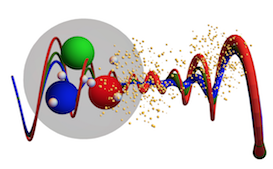Speaker
Description
We present a phenomenological analysis of events with two high transverse momentum (pT_{T}T) jets separated by a large (pseudo-)rapidity interval void of particle activity, also known as jet-gap-jet events. In the limit where the collision energy $\sqrt{s}$ is much larger than any other momentum scale, the jet-gap-jet process is described in terms of perturbative pomeron exchange between partons within the Balitsky-Fadin-Kuraev-Lipatov (BFKL) limit of perturbative quantum chromodynamics (QCD). The BFKL pomeron exchange amplitudes, with resummation at the next-to-leading logarithmic approximation, have been embedded in the PYTHIA8 Monte Carlo event generator. Standard QCD dijet events are simulated at next-to-leading order in αs_{s}s matched to parton showers with POWHEG+PYTHIA8. We compare our calculations to measurements by the CDF, D0, and CMS experiments at center-of-mass energies of 1.8, 7 and 13 TeV. The impact of the theoretical scales, the parton densities, final- and initial-state radiation effects, multiple parton interactions, and $p_T$ thresholds and multiplicities of the particles in the rapidity gap on the jet-gap-jet signature is studied in detail. With a strict gap definition (no particle allowed in the gap), the shapes of most distributions are well described except for the CMS azimuthal-angle distribution at 13 TeV. The survival probability is surprisingly well modelled by multiparton interactions in PYTHIA8. Without multiparton interactions, theoretical predictions based on two-channel eikonal models agree qualitatively with fits to the experimental data.

